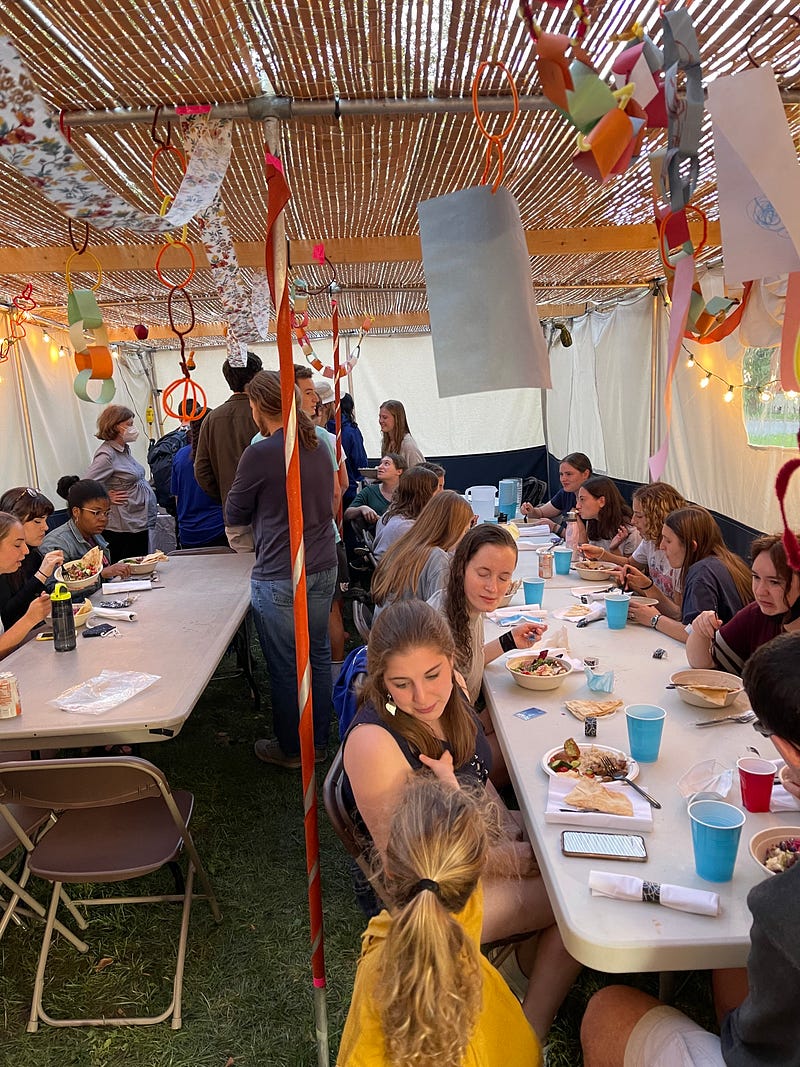
On Sunday, Sept. 19 at 10:00 a.m., members of Hillel and Rabbi Bair’s family gathered in the Sukkah, a temporary tent — translated as ‘hut’ from Hebrew — located between Commons Dining Hall and South Hall, to celebrate Sukkot. Hillel had a blend of traditional Jewish food and classic autumn treats, like bagels and cream cheese, babka, dates, apples, pumpkins and apple cider. The children of professors helped Hamilton students decorate their sukkah, with craft materials like colored paper, pipe cleaners, markers, duct tape, and ribbons. In most sukkahs, visitors can see the sky from inside, creating the effect of being one with nature. Traditional sukkahs have a roof made of plant materials like branches and leaves, but Hamilton students uniquely customized their Sukkah, tying colored paper together to hang decorations, like self-portraits and pumpkins.
Once the ceilings were full of decorations, students painted pictures and made gifts for each other. Rachel Saxon ’24 made crowns out of pipe cleaners for Chaya Bair, the daughter of Rabbi Bair and Professor Bair, and Arlo, a local professor’s son. Miriam Lerner ’24 joined the children in tracing their hands.
As the sign outside the traditional Jewish hut explains, it is tradition to eat in the Sukkah for eight consecutive nights to remember the shelters that Jewish people lived in while traversing the desert. In honor of this tradition, members of Hillel had dinner on Monday, Sept. 20th under the Sukkah. They ordered food from Lafa, a Mediterranean restaurant in New Hartford, and extended an invitation to all students. Students packed the Sukkah craving scrumptious, non-Commons, food, including falafel, chicken, pita bread, rice and tomatoes with feta cheese. Rabbi Bair passed around warm challah and chocolate babka from Trader Joe’s for dessert. Only ten people RSVP-ed to the event, but there was enough food for the thirty people who came. Following tradition, Hillel gathered the product of hadar trees (branches of palm trees, boughs of leafy trees, and willows of the brook) also known as the lulav and etrog, which grow in Israel. They serve as a symbol of joy and freedom following the High Holidays, a period of intense reflection. As the Torah instructs, students held these four species and rejoiced.
Sukkot might seem similar to Thanksgiving, which is not coincidental. According to some historians, the traditions and religious aspects of Sukkot helped shape Thanksgiving. Both holidays thank God for the fall harvest. In the next two months, as students prepare for Thanksgiving, they should remember the origins of their beloved turkey holiday.
Sukkot begins on a full moon, coinciding with Hamilton College’s first Full Moon Club meeting. Though there is no chanting and howling at the moon involved in Sukkot, the two events have some similarities. Both begin at nightfall before the 15th of the lunar month of Tishrei when the moon is at its zenith.
















